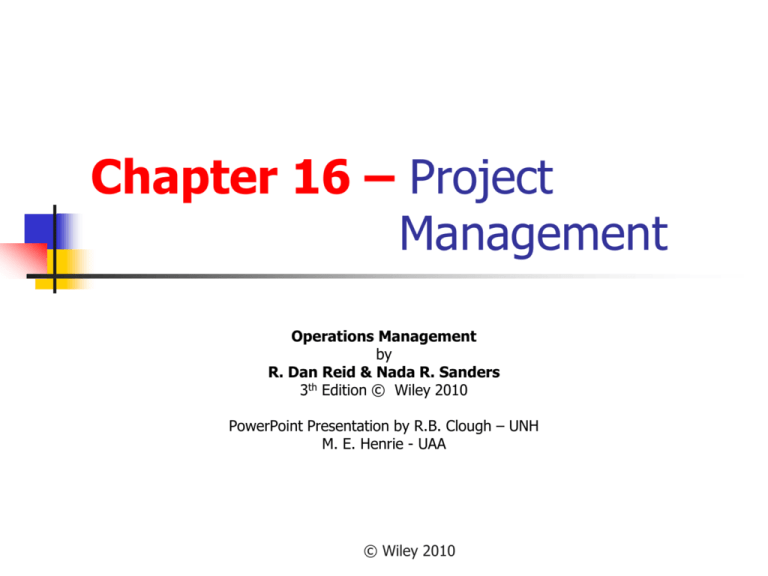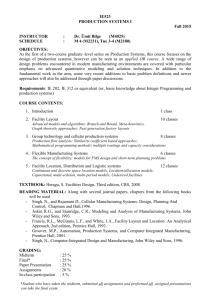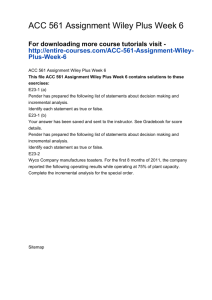Project Management: PERT, CPM, & Critical Path Analysis
advertisement

Chapter 16 – Project Management Operations Management by R. Dan Reid & Nada R. Sanders 3th Edition © Wiley 2010 PowerPoint Presentation by R.B. Clough – UNH M. E. Henrie - UAA © Wiley 2010 Project Management Applications What is a project? Any unique endeavor with specific objectives With multiple activities With defined precedent relationships With a specific time period for completion It is one of the process selection choices in Ch 3 Examples? A major event like a wedding Any construction project Designing a political campaign © Wiley 2010 Underlying Process Relationship Between Volume and Standardization Continuum © Wiley 2010 Project Life Cycle Conception: identify the need Feasibility analysis or study: costs benefits, and risks Planning: who, how long, what to do? Execution: doing the project Termination: ending the project © Wiley 2010 Network Planning Techniques Program Evaluation & Review Technique (PERT): Developed to manage the Polaris missile project Many tasks pushed the boundaries of science & engineering (tasks’ duration = probabilistic) Critical Path Method (CPM): Developed to coordinate maintenance projects in the chemical industry A complex undertaking, but individual tasks are routine (tasks’ duration = deterministic) © Wiley 2010 Both PERT and CPM Graphically display the precedence relationships & sequence of activities Estimate the project’s duration Identify critical activities that cannot be delayed without delaying the project Estimate the amount of slack associated with non-critical activities © Wiley 2010 Network Diagrams Activity-on-Node (AON): Uses nodes to represent the activity Uses arrows to represent precedence relationships © Wiley 2010 Step 1-Define the Project: Cables By Us is bringing a new product on line to be manufactured in their current facility in some existing space. The owners have identified 11 activities and their precedence relationships. Develop an AON for the project. Activity A B C D E F G H I J K Description Develop product specifications Design manufacturing process Source & purchase materials Source & purchase tooling & equipment Receive & install tooling & equipment Receive materials Pilot production run Evaluate product design Evaluate process performance Write documentation report Transition to manufacturing © Wiley 2010 Immediate Duration Predecessor (weeks) None 4 A 6 A 3 B 6 D 14 C 5 E&F 2 G 2 G 3 H&I 4 J 2 Step 2- Diagram the Network for Cables By Us © Wiley 2010 Step 3 (a)- Add Deterministic Time Estimates and Connected Paths © Wiley 2010 Step 3 (a) (Continued): Calculate the Path Completion Times Paths Path duration ABDEGHJK 40 ABDEGIJK 41 ACFGHJK 22 ACFGIJK 23 The longest path (ABDEGIJK) limits the project’s duration (project cannot finish in less time than its longest path) ABDEGIJK is the project’s critical path © Wiley 2010 Revisiting Cables By Us Using Probabilistic Time Estimates Activity A B C D E F G H I J K Description Develop product specifications Design manufacturing process Source & purchase materials Source & purchase tooling & equipment Receive & install tooling & equipment Receive materials Pilot production run Evaluate product design Evaluate process performance Write documentation report Transition to manufacturing Optimistic time 2 3 2 4 12 2 2 2 2 2 2 © Wiley 2010 Most likely time 4 7 3 7 16 5 2 3 3 4 2 Pessimistic time 6 10 5 9 20 8 2 4 5 6 2 Using Beta Probability Distribution to Calculate Expected Time Durations A typical beta distribution is shown below, note that it has definite end points The expected time for finishing each activity is a weighted average optimistic 4most likely pessimisti c Exp. time © Wiley 2010 6 Calculating Expected Task Times optimistic 4most likely pessimisti c Expected time 6 Activity A B C D E F G H I J K Optimistic time 2 3 2 4 12 2 2 2 2 2 2 Most likely Pessimistic time time 4 6 7 10 3 5 7 9 16 20 5 8 2 2 3 4 3 5 4 6 2 © Wiley 2010 2 Expected time 4 6.83 3.17 6.83 16 5 2 3 3.17 4 2 Network Diagram with Expected Activity Times © Wiley 2010 Estimated Path Durations through the Network Activities on paths ABDEGHJK ABDEGIJK ACFGHJK ACFGIJK Expected duration 44.66 44.83 23.17 23.34 ABDEGIJK is the expected critical path & the project has an expected duration of 44.83 weeks © Wiley 2010 Estimating the Probability of Completion Dates Using probabilistic time estimates offers the advantage of predicting the probability of project completion dates We have already calculated the expected time for each activity by making three time estimates Now we need to calculate the variance for each activity The variance of the beta probability distribution is: σ 2 po 6 2 where p=pessimistic activity time estimate o=optimistic activity time estimate © Wiley 2010 Project Activity Variances Activity Optimistic Most Likely Pessimistic Variance A 2 4 6 0.44 B 3 7 10 1.36 C 2 3 5 0.25 D 4 7 9 0.69 E 12 16 20 1.78 F 2 5 8 1.00 G 2 2 2 0.00 H 2 3 4 0.11 I 2 3 5 0.25 J 2 4 6 0.44 K 2 2 2010 © Wiley 2 0.00 Critical Activity Variances Activity Optimistic Most Likely Pessimistic Variance A 2 4 6 0.44 B 3 7 10 1.36 C 2 3 5 0.25 D 4 7 9 0.69 E 12 16 20 1.78 F 2 5 8 1.00 G 2 2 2 0.00 H 2 3 4 0.11 I 2 3 5 0.25 J 2 4 6 0.44 K 2 2 2 0.00 Critical activities highlighted © Wiley 2010 Sum over critical = 4.96 Calculating the Probability of Completing the Project in Less Than a Specified Time When you know: The expected completion time EFP 2 Its variance Path You can calculate the probability of completing the project in “DT” weeks with the following formula: specified time path expected time DT EF P z 2 path standard time σP Where DT = the specified completion date EFPath = the expected completion time of the path σPath 2 variance of path © Wiley 2010 Apply z formula to critical path Use Standard Normal Table (Appendix B) to answer probabilistic questions, such as Question 1: What is the probability of completing project (along critical path) within 48 weeks? 48 weeks 44.83 weeks z 1.42 4.96 © Wiley 2010 Probability of completion by DT Area = .4222 Probability = .4222+ .5000 =.9222 or 92.22% Project not finished by the given date Tail Area = .0778 Area left of y-axis = .50 0 Z92 = 1.42 © Wiley 2010 z Apply z formula to critical path Use Standard Normal Table (Appendix B) to answer probabilistic questions, such as Question 2: By how many weeks are we 95% sure of completing project (along critical path)? DT 44.83 weeks 1.65 4.96 © Wiley 2010 Probability Question 2 Area = .45 DT = 48.5 weeks Area left of y-axis = .50 Tail Area = .05 0 Z95 = 1.645 © Wiley 2010 z Reducing Project Completion Time Project completion times may need to be shortened because Different deadlines Penalty clauses Need to put resources on a new project Promised completion dates Reduced project completion time is “crashing” © Wiley 2010 Reducing Project Completion Time - continued Crashing a project needs to balance Shorten a project duration Cost to shorten the project duration Crashing a project requires you to know Crash time of each activity Crash cost of each activity © Wiley 2010 The Critical Chain Approach The Critical Chain Approach focuses on the project due date rather than on individual activities and the following realities: Project time estimates are uncertain so we add safety time Multi-levels of organization may add additional time to be “safe” Individual activity buffers may be wasted on lower-priority activities A better approach is to place the project safety buffer at the end Original critical path Activity A Activity B Activity C Activity D Activity E Critical path with project buffer Activity A Activity B Activity C Activity D Activity E © Wiley 2010 Project Buffer Adding Feeder Buffers to Critical Chains The theory of constraints, the basis for critical chains, focuses on keeping bottlenecks busy. Time buffers can be put between bottlenecks in the critical path These feeder buffers protect the critical path from delays in noncritical paths © Wiley 2010 Approaches to Project Implementation Pure Project Functional Project Matrix Project © Wiley 2010 A PURE PROJECT is where a self-contained team works full-time on the project Advantages The project manager has full authority over the project Team members report to one boss Shortened communication lines Team pride, motivation, and commitment are high Source: Chase, Jacobs & Aquilano, Operations Management 11/e Pure Project: Disadvantages Duplication of resources Organizational goals and policies are ignored Lack of technology transfer Team members have no functional area "home" Source: Chase, Jacobs & Aquilano, Operations Management 11/e Functional Project housed within a functional division President Research and Development Engineering Manufacturing Project Project Project A B C Project Project Project D E F Project Project Project G H I Example, Project “B” is in the functional area of Research and Development. Source: Chase, Jacobs & Aquilano, Operations Management 11/e Functional Project: Advantages A team member can work on several projects Technical expertise is maintained within the functional area The functional area is a “home” after the project is completed Critical mass of specialized knowledge Source: Chase, Jacobs & Aquilano, Operations Management 11/e Functional Project: Disadvantages Aspects of the project that are not directly related to the functional area get short-changed Motivation of team members is often weak Needs of the client are secondary and are responded to slowly Source: Chase, Jacobs & Aquilano, Operations Management 11/e Matrix Project: combines features of pure and functional President Research and Development Engineering Manufacturing Manager Project A Manager Project B Manager Project C Source: Chase, Jacobs & Aquilano, Operations Management 11/e Marketing Matrix Project: Advantages Enhanced communications between functional areas Pinpointed responsibility Duplication of resources is minimized Functional “home” for team members Policies of the parent organization are followed Source: Chase, Jacobs & Aquilano, Operations Management 11/e Matrix Project: Disadvantages Too many bosses Depends on project manager’s negotiating skills Potential for sub-optimization Source: Chase, Jacobs & Aquilano, Operations Management 11/e Project Management OM Across the Organization Accounting uses project management (PM) information to provide a time line for major expenditures Marketing use PM information to monitor the progress to provide updates to the customer Information systems develop and maintain software that supports projects Operations use PM to information to monitor activity progress both on and off critical path to manage resource requirements © Wiley 2010 Chapter 16 Highlights A project is a unique, one time event of some duration that consumes resources and is designed to achieve an objective in a given time period. Each project goes through a five-phase life cycle: concept, feasibility study, planning, execution, and termination. Two network planning techniques are PERT and CPM. Pert uses probabilistic time estimates. CPM uses deterministic time estimates. Pert and CPM determine the critical path of the project and the estimated completion time. On large projects, software programs are available to identify the critical path. © Wiley 2010 Chapter 16 Highlights (continued) Pert uses probabilistic time estimates to determine the probability that a project will be done by a specific time. To reduce the length of the project (crashing), we need to know the critical path of the project and the cost of reducing individual activity times. Crashing activities that are not on the critical path typically does not reduce project completion time. The critical chain approach removes excess safety time from individual activities and creates a project buffer at the end of the critical path. © Wiley 2010 Additional Example Activity Imm Pred optimistic most likely pessimistic 0 0 0 0 5 3 1 0 A 3 2 1 0 B 3 2 1 A C 4 3 2 A D 11 4 3 B E 5 4 3 C,D F 6 4 1 D,E G 5 4 2 F,G H Note: activity “0” is a formality. Source: Chase, Jacobs & Aquilano, Operations Management 11/e © Wiley 2010 ET sigma Additional Example Activity Imm Pred optimistic most likely pessimistic 0 0 0 0 5 3 1 0 A 3 2 1 0 B 3 2 1 A C 4 3 2 A D 11 4 3 B E 5 4 3 C,D F 6 4 1 D,E G 5 4 2 F,G H Note: activity “0” is a formality. Source: Chase, Jacobs & Aquilano, Operations Management 11/e © Wiley 2010 ET 0 3.00 2.00 2.00 3.00 5.00 4.00 3.83 3.83 sigma 0 0.44 0.11 0.11 0.11 1.78 0.11 0.69 0.25 Additional Example, continued C A 2 F 4 3 D 0 H 3 3.83 B G 2 3.83 E paths 0ACFH 0ADFH 0ADGH 5 © Wiley 2010 0BEGH Additional Example, continued C A 2 F 4 3 D 0 H 3 3.83 B G 2 3.83 E Critical Path: 0-B-E-G-H 5 Length © Wiley 2010 = 14.67 Additional Example, continued. Add variances along path to get path variance C 1.83 A F .83 .83 D 0 .83 0.11 0.25 H 0 B 0 1.78 G 0.69 0 E 0 © Wiley 2010 total=2.83 Probabilistic Analysis Additional Example, continued. Z-score Project completion times assumed normally distributed with mean 14.67 and variance 2.83 16 14.67 z .79 2.83 From table look-up, P(DT16) = .7549 14.67 16 Find the probability of completing the project within 16 days. © Wiley 2010 Probabilistic Analysis Additional Example, continued. Z95 = 1.645, thus Project completion times assumed normally distributed with mean 14.67 and variance 2.83 X 14.67 1.645 2.83 Solving for X=17.44 days 14.67 17.44 Find the 95-th percentile of project completion. © Wiley 2010 Example 2, #13-14 Ch 16: Activity Optimistic time Most likely time Pessimistic time Expected time Variance A 8 10 12 B 4 10 16 C 4 5 6 D 6 8 10 E 4 7 12 F 6 7 9 G 4 8 12 H 3 3 3 © Wiley 2010 Example 2, #13-14 Ch 16: Activity Optimistic time Most likely time Pessimistic time Expected time Variance A 8 10 12 10.00 0.444 B 4 10 16 10.00 4.000 C 4 5 6 5.00 0.111 D 6 8 10 8.00 0.444 E 4 7 12 7.33 1.778 F 6 7 9 7.17 0.250 G 4 8 12 8.00 1.778 H 3 3 3 3.00 0.000 © Wiley 2010 Example 2, #13-14 Ch 16: B(10) D(8) F(7.17) A(10) H(3) C(5) E(7.33) G(8) © Wiley 2010 Example 2, #13-14 Ch 16: PATH 1 B(10) D(8) A(10) F(7.17) H(3) Length = 38.17 © Wiley 2010 Example 2, #13-14 Ch 16: PATH 2 Length = 33.33 A(10) H(3) C(5) E(7.33) G(8) © Wiley 2010 Example 2, #13-14 Ch 16: PATH 3 B(10) D(8) A(10) H(3) Length = 39 G(8) © Wiley 2010 Example 2, #13-14 Ch 16: PATH 4 Length = 32.5 A(10) F(7.17) H(3) C(5) E(7.33) © Wiley 2010 Example 2, #13-14 Ch 16: CRITICAL PATH B(10) D(8) A(10) H(3) Length = 39 Path variance = 6.67 G(8) © Wiley 2010 Apply z formula to critical path Use Standard Normal Table (Appendix B) to answer probabilistic questions, such as Question 1: What is the probability of completing project (along critical path) within 36 weeks? 36 weeks 39 weeks z -1.16 6.66 © Wiley 2010 Probability of completion by DT Area left of y-axis = .50 Area = .3770 Probability = .5000 - 3770 =.1230 or 12.3% Project finished by the given date Tail Area = .1230 Z = -1.16 0 © Wiley 2010 z Apply z formula to critical path Use Standard Normal Table (Appendix B) to answer probabilistic questions, such as Question 2: What is the probability of completing project (along critical path) within 40 weeks? 40 weeks 39 weeks z 0.39 6.67 Probability = .6517 = 65.17% Question 3: By how many weeks are we 99% sure of completing project (along critical path)? D 39 weeks 2.33 T 6.67 DT = 45.02 weeks © Wiley 2010 Example 3, #4-8 Ch 16: Activity Optimistic time Most likely time Pessimistic time Expected time Variance A B C D E F G H I J 3 3 4 4 5 3 3 5 5 3 6 5 7 8 10 4 6 6 8 3 9 7 12 10 16 5 8 10 11 3 © Wiley 2010 6.00 1.00 5.00 0.44 7.33 1.78 7.67 1.00 10.17 3.36 4.00 0.11 5.83 0.69 6.50 0.69 8.00 1.00 3.00 0.00 Example 3, #4-#8 Ch 16: B(5) D(7.67) F(4) H(6.5) A(6) J(3) C(7.33) G(5.83) E(10.17) © Wiley 2010 I(8) Example 3, #4-#8 Ch 16: B(5) D(7.67) F(4) H(6.5) A(6) J(3) C(7.33) G(5.83) E(10.17) length =32.17 © Wiley 2010 I(8) Example 3, #4-#8 Ch 16: B(5) D(7.67) F(4) H(6.5) A(6) J(3) C(7.33) length = 35.50 G(5.83) E(10.17) © Wiley 2010 I(8) Example 3, #4-#8 Ch 16: B(5) D(7.67) F(4) H(6.5) A(6) J(3) C(7.33) G(5.83) E(10.17) length =37 © Wiley 2010 I(8) Example 3, #4-#8 Ch 16: B(5) D(7.67) F(4) H(6.5) A(6) J(3) C(7.33) length = 40.33 G(5.83) E(10.17) CRITICAL PATH © Wiley 2010 I(8) Example 3, #4-#8 Ch 16: B(5) D(7.67) F(4) H(6.5) A(6) J(3) C(7.33) G(5.83) E(10.17) Path variance =1+1.78+3.36+0.69+1+0 = 7.83 © Wiley 2010 I(8) Apply z formula to critical path Use Standard Normal Table (Appendix B) to answer probabilistic questions, such as Question 1: What is the probability of completing project (along critical path) within 38 weeks? 38 weeks 40.33 weeks z -0.83 7.83 © Wiley 2010 Probability of completion by DT=38 Area left of y-axis = .50 Area = .2967 Probability = .5000 - 2967 =.2033 or 20.33% Project finished by the given date Tail Area = .2033 Z = -0.83 0 © Wiley 2010 z Apply z formula to critical path Use Standard Normal Table (Appendix B) to answer probabilistic questions, such as Question 2: What is the probability of completing project (along critical path) within 42 weeks? 42 weeks 40.33 weeks z 0.595 7.83 Probability = .2257+.5000 = .7257 = 72.57% © Wiley 2010 Apply z formula to critical path Use Standard Normal Table (Appendix B) to answer probabilistic questions, such as Question 3: By how many weeks are we 99% sure of completing project (along critical path)? DT 40.33 weeks 2.33 7.83 DT = 46.85 weeks © Wiley 2010






